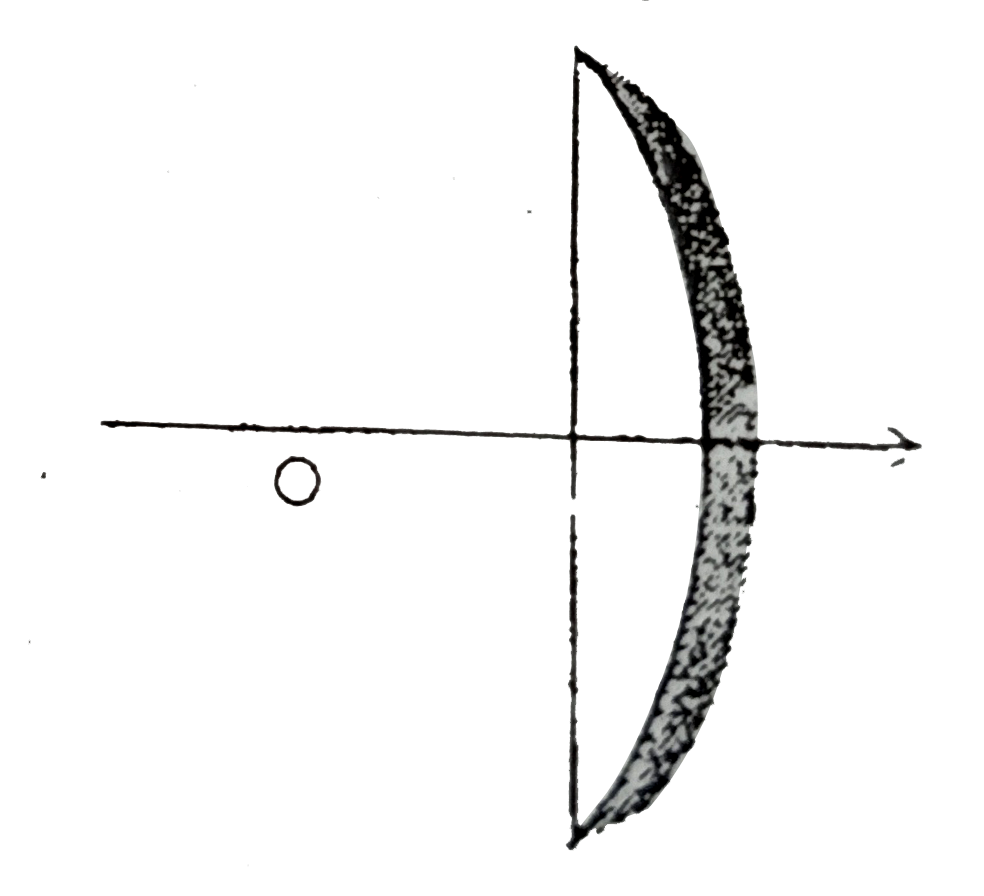A plano convex lens of refractive index 1.5 and radius of curvature 30cm. Is silvered at the curved surface. Now this lens has been used to form the image of an object. At what distance from this lens an object be placed in order to have a real image of size of the object.
60 cm
30 cm
20 cm
80 cm
The correct Answer is:C
To solve the problem, we need to analyze the situation step by step.
Step 1: Understanding the system
We have a plano-convex lens that is silvered on its curved surface. When the lens is silvered, it behaves like a mirror for light that is reflected from the silvered surface. The lens will refract light as it passes through, and then the silvered surface will reflect it back.
Step 2: Finding the focal length of the lens
The focal length (f) of a plano-convex lens can be calculated using the lens maker's formula:
1f=(n−1)(1R1−1R2)
For a plano-convex lens:
- n=1.5 (refractive index)
- R1=+30cm (radius of curvature of the convex surface)
- R2=∞ (the flat surface)
Substituting the values:
1f=(1.5−1)(130−0)=0.5⋅130=160
Thus, the focal length f is:
f=60cm
Step 3: Considering the silvered surface
When the lens is silvered, the effective focal length of the system changes. The silvered surface acts like a concave mirror. The focal length of a concave mirror is negative, so we can use the formula for the effective focal length f′ of the lens-mirror combination:
1f′=1f+1fm
Where fm=−30cm (focal length of the mirror).
Substituting the values:
1f′=160−130
Calculating the right-hand side:
1f′=160−260=−160
Thus, the effective focal length f′ is:
f′=−60cm
Step 4: Using the lens formula
Now we can use the lens formula to find the object distance u for a real image of the same size as the object:
1f′=1v−1u
For a real image of the same size, the image distance v is equal to the object distance u. Thus, we can set v=−u:
1−60=1−u−1u
This simplifies to:
1−60=−2u
Cross-multiplying gives:
−2=−u60
Thus:
u=120cm
Final Answer
The object should be placed at a distance of 120 cm from the lens to obtain a real image of the same size as the object.
---
We have a plano-convex lens that is silvered on its curved surface. When the lens is silvered, it behaves like a mirror for light that is reflected from the silvered surface. The lens will refract light as it passes through, and then the silvered surface will reflect it back.
The focal length (f) of a plano-convex lens can be calculated using the lens maker's formula:
- n=1.5 (refractive index)
- R1=+30cm (radius of curvature of the convex surface)
- R2=∞ (the flat surface)
When the lens is silvered, the effective focal length of the system changes. The silvered surface acts like a concave mirror. The focal length of a concave mirror is negative, so we can use the formula for the effective focal length f′ of the lens-mirror combination:
Now we can use the lens formula to find the object distance u for a real image of the same size as the object:
The object should be placed at a distance of 120 cm from the lens to obtain a real image of the same size as the object.
Topper's Solved these Questions
Similar Questions
A plano-convex lens is made of material having refractive index 1.5. The radius of curvature of curved surface is 60 cm. The focal length of the lens is ______ cm.
View SolutionFocal length of an equiconvex lens is 20 cm. The refractive index of material of the lens is 1.5. Now one of the curved surface is silvered. At what distance from the lens an object is to be placed, so that image coincides with the object ?
View Solution
Knowledge Check
A plano-convex lens has refractive index 1.6 and radius of curvature 60 cm. What is the focal length of the lens?
A50 cmB100 cmC200 cmD150 cmA plano-convex lens is made of glass of refractive index 1.6. the radius of curvature of its curved surface is 30 cm. What is the focal length of the lens ?
A50 cmB75 cmC100 cmD150 cmAn object is placed …………. Of a convex lens to get a real image with the size of the object.
Abeyond 2F1Bat 2F1CatF1DbetweenF1and2F1
An object is placed in front of a symmetrical convex lens with refractive index1.2and radius of curvature 40cm.the surface of the lens further away from the object is silvered.Under auto-collimation condition is ,the obejct distance is
View SolutionA convex lens of focal length f produces a real image m times the size of an object, then the distance of the object from the lens is
View SolutionA plano-covex lens is made of a material of refractive index n. When a small object is placed 30cm away in front of the curved surface of the lens, an image of double the size of the object is produced. Due to reflection from the convex surface of the lens, another faint image is observed at a distance of 10 cm away from the lens. Which of the following statement (s) is (are) true?
View SolutionA point object is placed in front of a silvered plano convex lens of refractive index n radius of curvature R, so that its image is formed on itself. Then the object distance is equal to

View SolutionA luminous object is placed at a distance of 30cm from the convex lens of focal length 20cm. On the other side of the lens, at what distance from the lens a convex mirror of radius of curvature 10cm be placed in order to have an upright image of the object coincident with it ?
View Solution
